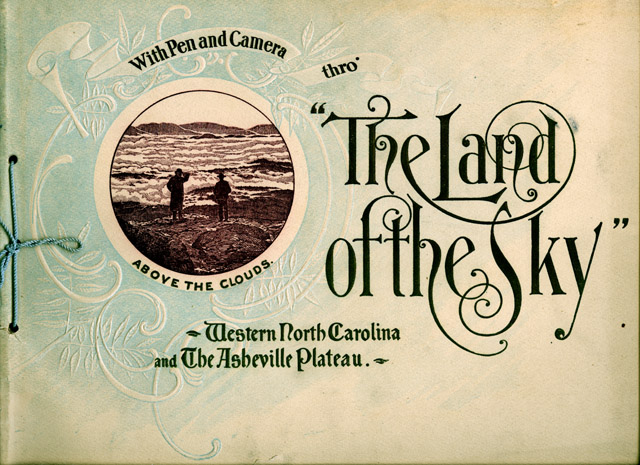|
Page |
Image |
Description |
Thumbnail |
| Cover |
lots000 |
Cover: "With Pen and Camera
thro' "The Land of the Sky" Western North Carolina and the Asheville
Plateau. Above the Clouds." |
 |
| 1 |
lots001 |
Front piece: "With Pen and
Camera thro' the "Land of the Sky" Western North Carolina and the
Asheville Plateau. Text by Holman T. Waldron. Copyright 1902, by
Chisholm Bros., Publishers, Portland, Maine. Chisholm Bros., Portland
ME." |
 |
| 2 |
lots002 |
"THE LAND OF THE SKY"
All the mountain regions of the Eastern United States
are closely allied to the great Appalachian range, which extends from
the St. Lawrence River through the whole length of Vermont, across the
western part of Massachusetts and the middle Atlantic States to the
northern part of Alabama, a total of 1,300 miles, with its greatest
width, about 100 miles, occurring midway its course. The White Mountains
of New Hampshire and the Adirondack Mountains of New York are outliers
of this range, while the Catskills form a link of the main range.
The Blue Ridge is the name given to the most eastern of the principal
ridges of the chain, prominent in Pennsylvania and Maryland and reaching
its culminating grandeur in Western North Carolina. Within the Old North
State more than one hundred noble peaks raise their heads above the
cloud-line. Forty-three of them are each higher than Mount Washington,
crown of New England.
Here, between the Blue Ridge upon the east and the Great Smoky
Mountains upon its western border, lies the beautiful Asheville plateau,
some six thousand square miles in area and with a general elevation of
two thousand feet above the sea. Hills, valleys, rivers and forests so
diversify this favored locality that the landscape from any point of
view presents a scene of unrivaled grandeur, beauty and fertility, as
the following series of views will attest.
The peculiar climatic features of the Asheville plateau, added to its
natural charm, have made of it a much sought health resort, receiving a
host of winter visitors from the North, while thousands of summer
tourists from the Southern States seek the cool, bracing air of its
mountains. Asheville, in the centre of this plateau, has a greater
elevation than any city east of Denver, Colorado, being 2,210 feet above
sea level. Its situation is at the junction of the waters of the
placidly beautiful Swannanoa with the impetuous French Broad River, in a
fair valley from which the mountains have drawn away and yet appear
rimming it about with verdure-clad peaks in an undulating perspective.
Charming natural parks and the richest private estate in America
surround it, while within easy excursion distance is some of the
grandest scenery of the State.
From Asheville to the Tennessee line, the rails of the Southern
Railway follow the tortuous windings of the French Broad River, crossing
it from bank to bank several times. Below Asheville the river flows
through an ever-deepening gorge, narrow as a Western canon and
inexpressibly grand, until it cuts its way through the Great Smoky
Mountains and reaches Tennessee. For thirty-six miles, or until the
mountain barriers fall back and no longer dispute its passage, the
waters well deserve their musical Cherokee name (Tahkeeostee, "The
Racing River") and are ever present, a car-window spectacle of alluring
interest.
The region is one of great local interest, a new-old country, quaint
alike in custom and in people. About it has been woven many a romantic
tale anent the traditions and loves of the inhabitants of the Great
Smoky Mountains, who live close to Nature in an unconventional freedom
of thought and action.
|
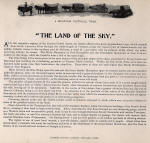 |
| 3 |
lots003 |
PANORAMIC VIEW IN THE BLUE RIDGE—RAILROAD AT SEVENTEEN
POINTS
Journeying from Washington toward Asheville the transition by rail
from plains to peaks is very abrupt, for toward the east the Blue Ridge
presents a bold front. Before one is aware that anything unusual is
ahead, for it has been steadily rising all the way from Salisbury, the
train is within this bowl, where it turns and doubles, in snake-like
movements, to avoid the greatest barriers and to overcome the elevation,
until, within the limited area embraced by the above picture, the
railroad shows at seventeen distinct points. Three times, at different
elevations, the train passes the central point in the floor of the
valley. The tracks, here shown elevated upon a viaduct of masonry
pierced by an archway through which foams a brawling stream, now enter
upon the loops which appear at the right of the picture where the tracks
rise one above the other upon four distinct terraces. This photograph
was taken from a great elevation and is the reward of long and patient
waiting for just the right conditions of atmosphere and sunlight. It is
the point most frequently shown in any exploit of the highlands of
Western North Carolina; a fitting introduction to the glorious scenery
beyond.
|
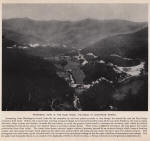 |
| 4 |
lots004 |
"The Blue Ridge Mountains"
and text.
THE BLUE RIDGE MOUNTAINS, NORTH CAROLINA.
That rugged barrier and watershed between the Atlantic Ocean and the
Mississippi Valley, the Blue Ridge (which divides all waters and is
pierced by none), traverses the entire State of North Carolina, from
northeast to southwest, with a rugged and broken escarpment facing the
east and with gentler western slopes robed with heavy forests. It is
strikingly and truly exemplified that the Blue Ridge forms the watershed
between the east and west thus : The Swannanoa tunnel pierces the crest
of these mountains ; Southern Railway trains enter from the Atlantic
slope and emerge into the Mississippi Valley. Within this tunnel there
is a spring, the waters of which flow east and west, joining streams
affluent to rivers which finally enter one the Atlantic Ocean, the other
the great Mississippi, "Father of Waters." Only in one other locality I
know does Nature draw her lines more closely. In the White Mountains of
New Hampshire, a northern spur of these same Alleghanies, the rain which
falls upon the roof of the Crawford House, a summer hotel situated at
the summit of the divide, is said to be separated by the apex of the
roof; that from the one side joining the Saco. that from the opposite
side flowing to the Connecticut.
|
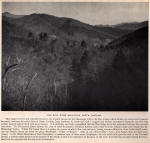 |
| 5 |
lots005 |
PENETRATING THE BLUE RIDGE —VIEW NEAR ROUND KNOB.
Before the building of a railroad which is to attack any difficult
mountain problem, much discussion is had upon the important question,
what shall be the maximum grade used. The engineers may attack the
elevation boldly by the short and heavy grade, or they may overcome the
grade by a loop or a series of loops at the expense of increased
mileage. Loops are the result of a comparatively recent engineering
scheme; they are used in two instances to conquer the Rockies, but the
loops at Round Knob in the Blue Ridge are the only examples in the East.
The nearest approach to it is the famous Horseshoe Curve of the
Pennsylvania Railroad used in crossing the Alleghanies. The Baltimore
and Ohio Railroad also crosses the Alleghanies, but it makes no attempt
at loops, attacking the grades boldly. Its only rival in the matter of
grades is the Maine Central Railroad, which pierces the heart of the
White Mountains of New Hampshire. When the latter road was in progress
of construction correspondence was had with the leading railroads of
America to determine what limit of grade could be safely and profitably
operated. It was found that the Baltimore and Ohio were operating a
grade of 119 feet to the mile. This was adopted by the Maine Central,
who have one grade of 119 feet to the mile for nine consecutive miles.
|
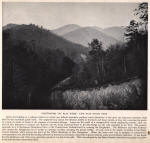 |
| 6 |
lots006 |
THE NANTAHALA RIVER AND GAP, "LAND OF THE SKY."
Southwest from Asheville, some two-score miles away, lies the gorge
of the Nantahala River, through which the Murphy branch of the Southern
Railway passes for more than a dozen miles. By many this gorge is
believed to be the most picturesque and beautiful in Western North
Carolina, where
"The mountains that shield from the rude northern blast — mute
monitors, they, of the ages long past — Like sentinels watch o'er the
valley below where the swift crystal streams unceasingly flow. The pure,
healthful breeze, the life-giving air, the beauteous landscape, oft new,
ever fair, Are gifts that have come from the Father on high; to Him be
all praise for "The Land of the Sky.'"
In some sentimental verse the Indian, in passing off the earth, is
made to say to his white brother : "Our name is on your waters, you
cannot wash it out." Nowhere is this more true than in North Carolina,
where one finds the Tuckaseegee, Savannah, Tennessee, Elijay,
Cartoogajay, Tuskeegee. Oconaluftee, Stekoah, Tusquitta, Nantahala and
kindred others.
|
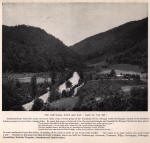 |
| 7 |
lots007 |
WOOD ROAD—HIGHLAND LAURELS.
The wood roads about Asheville, especially in the season of
rhododendron and mountain laurel bloom, are attractive beyond measure,
both from the beauty of those shrubs and from the great variety and
vigorous growth of the forest trees. Lying as it does near the centre of
distribution of the flora of Eastern North America, the supply of native
trees upon the Asheville plateau is naturally large and varied. The
greater part of these are deciduous, that is trees which shed their
foliage every year. Evergreens are in a decided minority, therefore a
hardwood growth is the result, with the white oak the most common. The
black oak, scarlet oak and Spanish oak follow in the order of frequency.
There are chestnuts, hickories, black gums, maples, tulip trees and now
and then a black walnut, but this last beautiful and valuable forest
tree has about disappeared from the forests of the South and middle
West, where it was once so common. Indeed the opening years of the
present new century will witness the passing of the black walnut. In
this connection it may not be amiss to quote the fact that twenty-one
Wagons passed in solemn procession through the streets of Wabash,
Indiana, recently, loaded with the last marketable black walnut logs in
the county. The ceremony would have been equally appropriate in any
other-county of the great central States, a strong argument for
protective forestry laws.
|
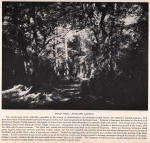 |
| 8 |
lots008 |
AN ASHEVILLE WOOD ROAD.
An enumeration of the different varieties of trees native to the
Asheville plateau is best found in the records of the Biltmore estate,
where Mr. Vanderbilt established one of the most complete arboreturns of
the world. The Biltmore forest comprises a little more than one-half the
estate (the eight thousand acres adjacent to the chateau), which
stretches along the banks of the French Broad River for about six miles.
The numerous small farmers, some forty in number, who owned the
properties of which the estate is made up, allowed the great profusion
of forest trees to grow in the most promiscuous fashion, more than half
a hundred varieties all mingled in luxurious profusion. For the benefit
of mankind, and especially for all interested in forestry, a careful
record of the treatment of the trees and their response is kept for a
forest botanical library, as magnificent and complete as everything else
in connection with the Biltmore estate. What is true of the Biltmore
estate with regard to the large number and variety of forest trees also
obtains to other localities in the vicinity of Asheville, save that Mr.
Vanderbilt has and is introducing others until he has in the Biltmore
nurseries more varieties of trees than there are in the Kew Botanical
Gardens, near London. Riding and driving in and about Asheville is very
enjoyable, as may be inferred from the above picture.
|
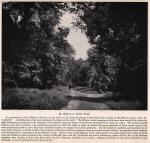 |
| 9 |
lots009 |
VIEW ON THE FRENCH BROAD RIVER NEAR HOT SPRINGS, NORTH
CAROLINA.
Mountain streams as a rule are fascinating on account of their
impetuosity. Then, too, they are the discoverers of the passes and in
many cases point the way to the engineers who follow with the steel
highways of commerce and tourist travel. Such is the French Broad, one
of the most beautiful, active and intrepid of Southland streams. It has
its rise in the Blue Ridge Mountains, flows across the Asheville
plateau, receives as tributary the Swannanoa just above the city of
Asheville, flows down across the Tennessee line and through the Great
Smoky Mountains to join forces with the Holston River, four miles above
Knoxville, and later with the Tennessee River, forming one of the
principal effluents of that historic stream. The French Broad shares
with the highlands of North Carolina the tourist's interest; it is the
jewel of the "Land of the Sky," in a most magnificent mountain setting.
The above view shows the river escaping from its mountain barriers at
Hot Springs, where it enters upon its more peaceful course. Beautiful in
its foliage-clothed banks, active in its impetuous rush, intrepid in its
bold assault of its mountain barriers, the French Broad is a river long
to be remembered as the beau-ideal of mountain streams.
|
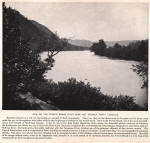 |
| 10 |
lots010 |
HICKORY NUT GAP, WESTERN NORTH CAROLINA.
Fourteen miles southeast from Asheville, reached in one of the
delightful drives which the region affords, is Hickory Nut Gap, a
beautiful pass through which the Rocky Broad River finds its outlet from
the encircling mountains. The entire length of the Gap is about nine
miles, while the lower or eastern gateway is not more than one-half mile
wide and is walled about on all sides by lofty bluffs. The mightiest
buttress of the gorge is here, on the south side, and though nearly
fifteen hundred feet high is quite perpendicular. Over a portion of this
precipice a stream of water flows and falls into an apparently
inaccessible pool below. A remarkable feature of the Hickory Nut Gap is
the salubrious climate which is enjoyed there. It seems to lie in some
favored belt and protected by its surrounding walls from inclement
weather, frosts and snow are strangers there. About nine miles beyond
the entrance to the Gap is the curious Chimney Rock, a picture of which
is presented on another page of this book. On the opposite side of the
gorge at this point rises Bald Mountain to a height of 3,860 feet. This
latter mountain, "Old Bald," is celebrated in Mrs. Frances Hodgson
Burnett's "Esmeralda."
|
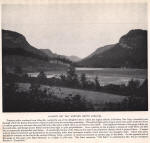 |
| 11 |
lots011 |
THE SOUTHERN RAILWAY, SKIRTING THE FRENCH BROAD RIVER.
From a point just out of the city of Asheville the rails of the
Southern Railway, on its route to the West, approach the French Broad
River and for many miles follow the intricate and tortuous windings of
that remarkable stream, crossing and re-crossing from bank to bank many
times as the exigencies of the situation render necessary. For the
entire distance to the Hot Springs, thirty-eight miles, the river view
from one or the other side of the train is never absent. From Asheville,
with its elevation of 2,210 feet, to Hot Springs, with its elevation of
1,345 feet, is a drop of 865 feet, or of twenty-three feet to the mile.
This is sufficient to give a mighty impetus to the waters, which flow
through an ever-deepening gorge, in their musical progress earning well
the title bestowed by the Cherokees, Tahkeeostee, the ''Racing River."
Following springtime rains, the surface of the river, in its course
through the gorge, has the appearance of a miniature Niagara as the
crested wavelets chase one another down the stream. While this display
is at its height suddenly the mountain walls sink away and the river,
tired of strife, glides out into tranquil pools and meanders lazily
through the broad pastoral valley of the Hot Springs.
|
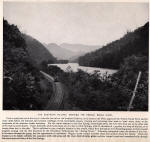 |
| 12 |
lots012 |
THE FRENCH BROAD RIVER NEAR THE TENNESSEE LINE.
When riding swiftly along by rail westward from Salisbury, North
Carolina, toward the "Land of the Sky," it will be interesting to
compare your condition and surroundings of today, luxuriantly embowered
in plush and mahogany, catered to, warmed and fed to the limit, with
that small army of fugitives who have welcomed the sight of the Blue
Ridge under entirely different conditions. Particularly do I refer to
those escaped Federals from the Salisbury prison-pen, who toiled over
these same mountain trails, foot-sore, weary, hungry and cold, with
their desires set upon reaching Knoxville, Tennessee, and the Union
lines. Traveling only at night, hiding out by day, fed by negroes and by
the loyal North Carolina and Tennessee mountaineers on their invariable
pork and cornbread, how different must have been their impressions of
such scenes as the above. Hundreds have thus escaped to the North from
Southern prisons ; many, too, have been recaptured and brought back to
the stockade. In those dark days of war, before even the locomotive
pierced those mountain fastnesses, how cheerless must have been their
greeting. But above their summits floated the North Star and in the
dauntless breasts of the fugitives burned hope and thoughts of home, so
they pressed on. One may gaze from the car window today and try to
imagine it.
|
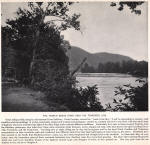 |
| 13 |
lots013 |
MOUNT MITCHELL, MONARCH OF THE EAST.
Neither the Blue Ridge on the east nor the Great Smoky on the west,
the two border mountain chains to the Asheville plateau can boast of the
highest peak in North Carolina. That distinction belongs to the
transverse chain, the Black Mountain, which presents a series of lofty
summits cross-country, connecting the two border ranges. Black Mountain,
with its two great branches, is over twenty miles long. Its rugged sides
are covered by a wilderness of almost impenetrable growth. Above a
certain elevation no timber grows save the hardy balsam fir, from the
dark color of whose foliage Black Mountain takes its name. Why this
long, transverse range should be spoken of in the singular number is a
curiosity of localism, it bears many of the highest peaks of the region
in its comparatively snort extent of twenty miles, and among them Mount
Mitchell, the highest mountain east of Colorado. Lying out in leonine
grandeur along the horizon, Mount Mitchell and its attendant peaks
invite rather than repel by their graceful symmetry and color.
|
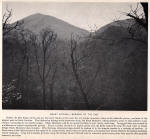 |
| 14 |
lots014 |
MOUNT MITCHELL FROM CLINGMAN'S DOME —ABOVE THE CLOUDS.
This view of Mount Mitchell, the sovereign summit east of the Rocky
Mountains (6,711 feet), is from Clingman's Dome, the highest peak of the
Great Smoky Mountains, 6,660 feet above the sea. As will be seen, the
camera in taking this picture was directed through a vista opening amid
dense foliage in which appears, filling the entire foreground of the
picture, a bank of the beautiful rhododendron blossoms, which are such
an adjunct to the May and June landscape of Western North Carolina.
Above the Clouds. This view proves that the title, "The Land of the
Sky," so generally bestowed upon Western North Carolina, is not merely
fancy. Many a coign of vantage in this mountain region allows one to
reach an elevation above the clouds and look down upon the surging mass
of mists below, which, stirred by every breeze that blows, advance and
recede with silent, ghost-like movement. Projecting through the clouds
which fill the valleys, summit after summit appears piercing the mists
to rise into the clear air above.
|
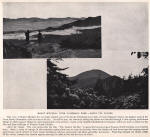 |
| 15 |
lots015 |
WHITESIDE MOUNTAIN, NORTH CAROLINA — LOOKING EAST.
Whiteside Mountain is in many respects the most striking peak in
North Carolina. Rising to a height of more than 5,000 feet, its
southeastern face is an immense precipice of white rock, which, towering
perpendicularly 1,800 feet, is fully two miles long and curved so as to
form the arc of a circle. Whiteside is no misnomer; the mountain is well
named. The ascent to the summit can be made partly on horseback, for it
presents no difficulties; the view is one of surpassing grandeur. To the
northeast, as far as the eye can reach, rise a multitude of sharply
defined blue and purple peaks, the valleys between them, vast and filled
with frightful ravines, seeming from this elevation to be the merest
gullies on the earth's surface. Farther off than this line of peaks rise
the dim outlines of the Balsam and Great Smoky Mountain ranges. The
camera is not capable of portraying the scene in half its intense,
thrilling beauty; indeed, when brought into play on mountain scenery the
photographer's art is particularly impotent None feels this more than
the man who focuses his lens upon a scene like the above.
|
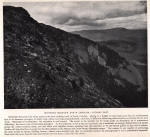 |
| 16 |
lots016 |
VIEW ON THE SWANNANOA, "LAND OF THE SKY."
The Swannanoa River, mountain-born upon the summit of the Blue Ridge,
is typical of many a Southland stream — river, branch and creek —
flowing among the ''Coves'' (clearings) and beneath the ''Balds'' of the
Blue Ridge, Great Smoky and Cumberland Mountains — localities that are
peopled by that strange race of hardy, honest, though unlettered whites,
who form such attractive sociological subjects as they appear stalking
through the pages of those charming bits of fiction which none save a
native of the region could produce, but which every one, especially
those favored ones who have known the "Land of the Sky," can thoroughly
enjoy. Charles Egbert Craddock (Miss Murfree), with her "In the
'Stranger People's' Country," "The Prophet of the Great Smoky Mountains"
and other stories; John Fox, Jr., with his "Mountain Europa" and his
"Cumberland Vendetta," have portrayed to the life the manner, customs
and dialect of the Southern mountaineer. His cabin, his family and his
uncouth self are much in evidence on the beaten path of railroad travel
through the "Land of the Sky." Back from the railroad, hidden in his
mountain clearing, he lives near to Nature and in true
unconventionality.
|
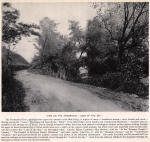 |
| 17 |
lots017 |
WHITESIDE MOUNTAIN, NORTH CAROLINA —LOOKING WEST.
But to the human eye the scene appears in all its transcendent
beauty. The lenses with which the Creator Endowed man are of seemingly
unlimited power when brought into use from an elevation of five thousand
feet amid such surroundings. In the distant southwest, looking across
into the State of Georgia, one can descry Mount Yonah, lovely and
superb, with a cloud-wreath round its brow. Sixty miles away, in South
Carolina, on a bright day appear the roofs of the little German
settlement of Walhalla. Beyond the precipices and ragged projections in
the foreground tower other peaks, Chimney-top, the Hog-back, Cold
Mountain, Yellow Mountain—everywhere precipitous cliffs, wooded summits,
dark ravines. It is like viewing the world from a balloon. In this "Land
of the Sky " occur many lovely glens and fertile "coves" (clearings),
surrounded by high, wooded ridges and profound forests. Here are the
quaint hamlets and lonely farms of the mountaineers so aptly pictured by
the facile pen of Charles Egbert Craddock, notably in the story, "The
Prophet of the Great Smoky Mountains."'
|
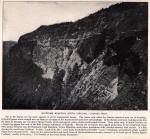 |
| 18 |
lots018 |
THE NANTAHALA VALLEY, NORTH CAROLINA.
The Cherokee title, Nantahala, signifies the light of the noonday sun
within its dark glens. It hath a pleasant sound to the nineteenth
century ear and is also indicative of the poetical mind of the
aborigine. He, in the person of the Cherokee tribe, was a mighty power
in the Southland. His sixty towns and six thousand warriors allied with
the British in their wars with the French and afterwards in harassing
the American colonists. So late as the opening of the American Civil War
many Cherokees remained hidden amid their native mountain fastnesses,
and four companies of them enlisted in the Confederate army. Others
joined the Tennessee regiments fighting for the Union. Locality seems to
have been responsible for this diversity of opinion. Today there are
about 3,000 of the tribe dwelling in North Carolina. This Eastern band
of Cherokees are mainly full-bloods. They have five day schools and a
training school conducted by the society of Friends. They also enjoy the
privilege of voting and are reported to be Republicans almost to a man.
The Cherokee seems to be the highest type of the American Indian. He was
the first if not the only tribe to have a written language of his own.
He enjoys in North Carolina the right to vote on State and National
questions, while he holds his own council and elects his own chief every
four years.
|
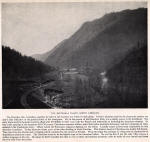 |
| 19 |
lots019 |
STROUP'S TRESTLE, IN THE BLUE RIDGE, NORTH
CAROLINA.
The difference in slope between the eastern and western sides of the
Blue Ridge Mountains is admirably shown by the profile of the Southern
Railway's route from Salisbury, North Carolina, to Asheville. From
Salisbury the train ascends by an easy grade through a broad valley to
the Piedmont plain, where at Marion, one hundred miles west of Salisbury
and 1,400 feet above the sea, it finds the level of the Catawba River.
From this point the ascent is abrupt indeed and the train boldly assails
the gap. By a series of intricate loops, at Round Knob, winding back and
forth upon the mountain side, it reaches the summit of the divide, 2,480
feet above the sea, and plunges through the Swannanoa tunnel. From the
Swannanoa summit of the divide the train descends again, following the
valley of the Swannanoa River to Asheville, eighteen miles west of and
480 feet below the divide. The extreme of grade in the passage of these
mountains is 120 feet to the mile and is reached at the five tunnels
which succeed each other rapidly before the final tunnel at the summit
of the divide.
|
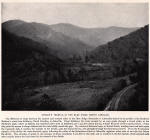 |
| 20 |
lots020 |
FALLS OF THE CATAWBA RIVER, BLUE RIDGE MOUNTAINS,
NORTH CAROLINA.
A striking characteristic of the Blue Ridge is the great difference
in slope of its opposite sides. Those mountain streams originating on
the divide flow westward toward the Mississippi Valley through broad,
smooth valleys for miles before reaching the narrow, rock-cut gorges of
their lower courses. On the contrary, those flowing eastward toward the
Atlantic Ocean from their very birth plunge downward in a series of
cascades, falling thousands of feet in the distance of a few miles. They
have no valleys, only sharply defined rock gorges, until they reach the
level of the Piedmont plateau, which lies between the heights of the
Blue Ridge and the still lower coast belt. Such is the Catawba, one of
the eastward flowing rivers, wild and picturesque as it foams and falls
over rocky terraces in musical cascades through its wild and rugged
mountain gorge. Just as the rails follow the course of the French Broad
River out of ''The Land of the Sky," so they follow the course of the
Catawba River into that favored region. One gets to know the Catawba
passing well in the journey from Salisbury toward the Blue Ridge, but it
is not to be compared with the French Broad in interest.
|
 |
| 21 |
lots021 |
TUCKASEEGEE FALLS — "LAND OF THE SKY"
Bordering the Asheville plateau upon the west, separated from North
Carolina by the hazy outline of the Great Smoky Mountains but in no wise
distinct from the " Old North State " in appearance and people, lies
that remote and beautiful region, East Tennessee. North of and
paralleling the Great Smoky are the Cumberland Mountains, separating
likewise the sister States of Kentucky and Virginia. Have one point of a
pair of compasses placed upon the city of Asheville and the other swept
in a circle of one hundred miles from that centre, the area encompassed
would include parts — and the most intensely interesting parts — of the
Blue Ridge, Great Smoky and Cumberland Mountains, and also touch the
States of North Carolina, South Carolina, Georgia, Tennessee, Kentucky
and Virginia. All these mountain ranges, with their distinctive names,
are part of the great Appalachian system, whose culminating grandeur is
to be found within this limited circle. One climbs into its centre,
Asheville, from the east surmounting the abrupt escarpment of the Blue
Ridge and from the west over the less stern barrier of the Great Smoky.
The journey can be accomplished by rail now with luxurious ease,
consequently more tourists are year by year visiting here, yet before
the advent of the palace car the charms of the region were sufficient to
lure the tourist-traveler to risk his limbs in the stage-coach.
|
 |
| 22 |
lots022 |
LINVILLE RAPIDS — "LAND OF THE SKY"
The character of the country about the Linville Gap is best shown by
the pictures here presented of the rapids and falls of that most
remarkable mountain stream. How the waters pour in a boiling flood over
the ledges of bald rock, worn deep and smooth by the erosion of years,
until they spring from the precipice to fall a seething white flood into
the deep, dark pool below. Here the foam-white character of the water is
intensified to a degree by the dark, somber-hued rock which is brought
into contrast with it. It is easy, in view of such scenes, to believe
the undisputed evidence which we have that North Carolina of the
sixteenth century lay hidden under noble forests of almost tropical
richness and variety. Thousands of miles yet remain, although of late
years the mountain forests have been heavily attacked on all sides and
lumber exported in great quantities. Two-thirds of the tar and
turpentine produced in the United States comes from the North Carolina
pineries, a belt of sandy barrens from thirty to eighty miles wide which
extends southwest across the State from Virginia.
|
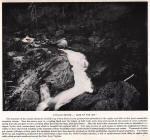 |
| 23 |
lots023 |
GORGE OF THE LINVILLE RIVER —BLUE RIDGE MOUNTAINS.
From Hickory station on the Southern Railway, eighty-three miles east
of and on the direct route between Salisbury and Asheville, a connecting
railroad, the Carolina & Northwestern, extends for twenty miles
northwest to Lenoir. From Lenoir a stage-line passing through some of
the wildest scenery in the South reaches the gorge of the Linville
River, a tributary to the Catawba. The scenery of the Linville River and
Gap is wild in the extreme. On every hand appear vast chasms, ghastly
rents and massive, towering rocks that are scored and seamed by time.
The environment of Linville is most picturesque, and here has grown up a
new summer resort high among the clouds. Linville lies between the
Grandfather Mountain (the highest Blue Ridge peak, 5,897 feet) on the
north and Roan Mountain (in the Great Smokies, 6,306 feet) on the south,
in near proximity to both. It is one of the recently discovered health
and pleasure resorts of the new South, of which there are many
throughout the " Land of the Sky." What with medicinal springs, " Hot
Springs," "White Sulphur," "Lithia," ''Chalybeate," etc., together with
its glorious climate, the Southland though newer at the game than many
of its northern rivals seems to have secured very prominent cards and is
winning a larger following from the tourist ranks every year.
|
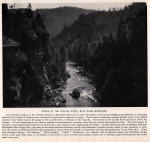 |
| 24 |
lots024 |
WHITESIDE MOUNTAIN FROM ALLEY'S, WESTERN NORTH
CAROLINA.
Very rarely does a ledge of bald rock show through the vegetation
which clothes these mountains. Their sides are smoothed and summits
softened by the dense foliage which at a moderate distance seems to
clothe them entire. This aspect is not so grandly stern and
awe-inspiring as the appearance of unforested mountains of less
elevation; notably the White Mountains of New Hampshire, many of whose
summits are far above the timber line. The atmospheric conditions, too,
are peculiar; a soft blue haze predominating, into which the distant
mountain tops melt and fade away a condition which is to be recognized
in the names of both the Blue Ridge and the Great Smoky Mountains. This
condition of the atmosphere pleasantly softens the details of objects
near at hand and gives the effect of great distance to mountain peaks
which are but a few miles away. Thus elevations of comparatively
moderate altitude often afford more impressive views than heights and
distances two or three times as great seen through the clear air of the
West and North.
|
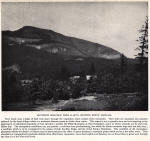 |
| 25 |
lots025 |
THE SWANNANOA RIVER, NORTH CAROLINA.
"Swannanoa! Nymph of beauty!
I would
woo thee with my rhyme,
Brightest,
gladdest, sunniest river
Of our
sunny Southern clime." .
It was Sidney Lanier, the Southern artist-poet, who thus
apostrophized this peaceful stream. It was Christian Reid, the novelist,
who gave to Western North Carolina that name by which it is now so
generally known, "The Land of the Sky." Pleasantly euphonious are the
old Cherokee names which still cling to the waters of the "Old North
State," albeit the musical Indian title, Tahkeeostee ("Racing River")
has become known as the French Broad. Still the latter title is so far
out of the commonplace as to render it distinctive. Swannanoa
perpetuates the sound of its multitudinous ravens wings; Tuckaseegee,
the terrapins of its valley ponds; Nantahala, the noonday sun, and
Cullasaja, the sweet waters.
|
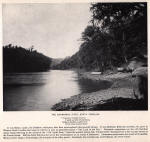 |
| 26 |
lots026 |
MITCHELL'S POOL —THE OLD BLACK MOUNTAIN GUIDE.
Black Mountain (note Black Mountain station on the Southern Railway,
sixteen miles east of Asheville) crosses the high plateau which exists
between the Blue Ridge and the Great Smoky ranges, forming the most
majestic of the several cross-ranges, spurs of the main chains, among
which are Balsam, Pisgah, Cowee and Nantahala Mountains. Black Mountain
extends in one long serrated ridge for twenty miles, from the eastern to
the western chain which encompasses the Asheville plateau. It has
eighteen peaks that are each above six thousand feet high, including in
that number Mount Mitchell, the dominating peak of the Alleghanies
(6,711 feet above the sea). Mount Mitchell commemorates in its name the
memory of Professor Elisha Mitchell, of the University of North
Carolina, who lost his life in the year 1857, while engaged in measuring
the altitude' of this peak. Professor Mitchell, wandering in the
darkness on the mountain, fell into this deep pool of water, which, like
the mountain, perpetuates his name, and was drowned. There "Big Tom"
Wilson, the old Black Mountain guide (shown in the picture), found and
recovered the body, which has since rested with the giant mountain for a
tombstone, albeit a bronze monument was erected over the grave in 1888.
|
 |
| 27 |
lots027 |
CHIMNEY ROCK, HICKORY NUT GAP.
This is one of the most interesting natural phenomena of the region.
It is off the beaten path of railroad travel; to be enjoyed in an
all-day ride or drive from Asheville. Its appearance fully bears out its
title. Mark its smoothed sides, which rise far above the gorge, cut as
with a giant plane, by what — the ice cap of the glacial period? Unlike
Paint Rock (see plate to follow), on the border of North Carolina with
Tennessee, Chimney Rock, although of much the same character, is not in
local fancy attributed to the hand of man. The aborigines, so say the
natives, decorated Paint Rock. One gets a good car-window view of this
prehistoric mural painting as he journeys out of the Asheville plateau
through the gateway cut by the French Broad. These two are all the very
peculiar formations which the region presents to the tourist's notice,
peculiar in a legendary or fantastic sense. Not so rich in this respect
are these over-towering mountains of the Southland as their Northern
kindred, the Franconias of New Hampshire with their Profile — the real
"Old Man of the Mountain.'
|
 |
| 28 |
lots028 |
LOVER'S
LEAP, PICTURESQUE PRECIPICE NEAR
HOT
SPRINGS, NORTH CAROLINA.
No doubt many of our readers have expected in this book to meet a
view entitled "Lover's Leap", here it is. Such titles are never absent
from any district which affords elevation enough to make a proper
realistic leap, whether the legend bears out the romantic cognomen or
not. Few, however, are so beautiful as this more than perpendicular
precipice of bold rock, which rises immediately above the tree-embowered
carriage road which skirts the French Broad River, with the dissolving
heights of the Great Smoky Mountains for a horizon. Just below this rock
the left bank of the river widens out into a level plain. Here are the
Hot Springs, with their spacious hotel resting in a delightful little
valley one mile in diameter, surrounded by mountains of from three to
four thousand feet altitude. These springs are among the most noted in
the Southern States, and their virtues have been known for nearly a
century. The waters, a chemical combination of carbonic acid, sulphuric
acid, hydrogen, lime and magnesia, though quite palatable as a beverage,
is taken chiefly in the form of baths, for which there are charming
facilities, the waters being drawn into marble and porcelain tubs. Their
use is recommended for numerous ailments including, curiously enough,
nervous prostration.
|
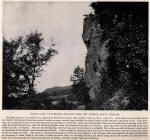 |
| 29 |
lots029 |
THE PAINTED ROCKS, NORTH CAROLINA-TENNESSEE BOUNDARY.
Five miles below Hot Springs, on the Tennessee boundary, the train
passes upon the opposite bank of the French Broad beneath the bold
precipice of the Painted Rocks, a titanic mass above two hundred feet in
height, whose face is strongly marked with red, locally credited with
being done by the aborigines. Be that as it may, there is mystery in
these mountains; relics as well as legends of a prehistoric people,
mound-builders, as well as the later Cherokees. Miss Murfree speaks of
"Legends of the old Cherokee settlement, Chota, 'the beloved town,' city
of refuge where even the shedder of blood was safe from vengeance; the
mysterious ark, before which sacrifices were offered; Hebraic words in
the Indian ritual of worship; the great chieftain, Oconostota, and his
wonderful visit to King George in London; the bravery of
Atta-Culla-Culla; the Indian sibyl known as Evening Cloud and the
strange fulfillment of many of her singular prophecies. Surely there are
stranger things to believe than that the hand of man decorated Paint
Rock. From an archaeological standpoint the mountains of East Tennessee
have great attractions in addition to their beauties of scenery.
|
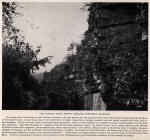 |
| 30 |
lots030 |
THE ROYAL GORGE, BLUE RIDGE MOUNTAINS, NORTH CAROLINA.
Riding down from Washington, through Virginia, into and through North
Carolina to Asheville, the visitor from the North is filled with
surprise to note from what a sparsely settled country the South
recruited her large and valiant army. Put this question to a Southern
man and he will tell you that every one went to the front; that North
Carolina, for instance, sent more soldiers into the Southern army than
she had voters. This, too, in spite of the fact that the Old North State
remained true to the Union while all her surrounding sisters had seceded
and then only joined her fortunes with the Confederacy when President
Lincoln called upon her to furnish her quota of troops for the Federal
army. In the struggle which followed North Carolina sent forth more
troops and lost more men than any other of the seceding States. These
included 89,344 volunteers, 18,583 conscripts and 19,000 reserves and
militiamen, enrolled in sixty-two regiments of infantry, six of cavalry
and three of artillery. More than 50,000 of these men died in the
service or were wounded in action. Many of the most desperate battles of
that bloody period were fought on North Carolina soil, while the hotly
contested struggles about her eastern seaports are famous in the history
of the rebellion. The war left the State bankrupt and prostrate, but
marvelous advancement has been made since then in population,
agricultural lands, railroads and diversified industries.
|
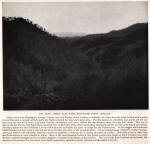 |
| 31 |
lots031 |
THE FRENCH
BROAD, FROM RICHMOND'S HILL—
A FEW
WORDS CLIMATIC.
But little has been said so far concerning the enviable climate of
North Carolina, one of the subjects of particular interest to the
health-seeker. The parallels of latitude denote that the State lies
nearly midway the Union, which is itself entirely within the temperate
zone. Situated in the centre of this zone, it naturally follows that
North Carolina enjoys a golden mean between the rigors of the North and
the heat of the extreme South. Upon the elevated Asheville plateau and
throughout the "Land of the Sky" there is perfect freedom from torrid
heat or icy blasts. An equal temperature and azure skies, into which the
summits of the Blue Ridge fade away, are agents which produce a tonic
atmosphere, filling one with vitality. The climate is pre-eminently a
suitable one for those who seek relief from asthma, hay fever, malaria,
nervous prostration, exhaustion, from overwork or long continued summer
heat; for all of which the medium altitude of the Asheville plateau is
recommended by physicians.
|
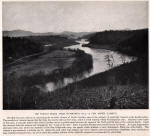 |
| 32 |
lots032 |
THROUGH THE TUNNELS TO ASHEVILLE, THE CITY OF MANY
VISITORS.
Since the close of the war thousands of persons from the Northern
States have found relief from pulmonary diseases in the Blue Ridge. The
centre of this golden mean is Asheville, a city with a permanent
population of about 20,000, swelled by visitors at all seasons; from the
Northern States during the winter months and from the Southern States
during the heated term. This floating population is estimated at several
thousands, to accommodate whom Asheville has numerous hotels and
boarding-houses of every degree of excellence and price. The climate is
all that can be desired; never hot and never cold. The mean temperature
of spring is 53°; of summer, 71°; autumn, 53°; and winter, 39°
Fahrenheit. For the entire year, 54°, with a mean relative humidity of
but 65 per cent. To approach the Asheville plateau by rail from the
Atlantic side of the Blue Ridge one passes through numerous tunnels of
greater or less extent. There are five of these tunnels which follow one
another closely, within two miles, at an elevation of from 2,300 to
2,500 feet. In conjunction with the loops they assist to place the train
upon the Asheville plateau. They are called Licklog, McElroy, High
Ridge, Bergen and finally the Swannanoa tunnel through the summit of the
divide. The above picture is through two of the smaller, Licklog and
McElroy, looking toward Asheville.
|
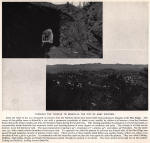 |
| 33 |
lots033 |
FAIRFIELD
LAKE AND HOTEL FROM BALD ROCK —TOXAWAY LAKE AND INN FROM
TOXAWAY
MOUNTAIN.
The beautiful Sapphire County — Here amid the mountains of Western
North Carolina, at an altitude of 3,000 feet, typifying in their
environments of wonderful scenic grandeur and beauty the idyllic natural
attractions of the Asheville Plateau, two beautiful lakes, Fairfield and
Toxaway, with placid surfaces mirroring sun-lit skies 280 days during
the year, welcome those seeking health, rest and recreation.
In beautiful Sapphire County is situated the Toxaway estate,
embracing thirty thousand acres, with improved roads and trails,
rendering the wide diversity of natural scenery easily accessible from
its several hotels, which provide all the luxurious comforts exacted by
the most fastidious.
|
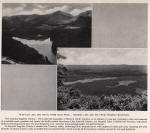 |
| 34 |
lots034 |
BILTMORE HOUSE—EAST FRONT.
The owner of the vast Biltmore estate, Mr. George W. Vanderbilt, has
without doubt the finest country place in America, and there are few, if
any, in the world to compare with it in elegance of design and splendor
of setting. The chateau was begun in 1890 and completed in 1895, at a
cost of three million dollars, under the direction of the eminent
architect, the late Richard M. Hunt, and is a chateau of the French
Renaissance, 375 feet long by 150 feet wide. Four million more are said
to have been expended in the purchase of land and improvements thereon.
By the term estate is here meant the lands and forests about Biltmore
House. These equal 12,000 acres in area, about half of which is forest;
the remainder is in farms, gardens and nursery plantations. Outside of
these home fields and forests Mr. Vanderbilt owns some 120,000 acres,
known as Pisgah Forest, extending farther back into the mountains and
including Mount Pisgah, some 5,000 feet in altitude. Both the Swannanoa
and the French Broad Rivers water the estate, which is bordered by the
latter glorious river for a distance of six miles.
|
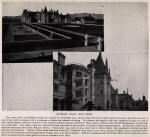 |
| 35 |
lots035 |
BILTMORE
HOUSE — THE CHATEAU FROM
SOUTH
TERRACE.
One sees nothing of Biltmore House itself from Biltmore Station. A
drive or walk from Asheville reveals it in all its beauty. How
delightful are the smooth stone roads with which all parts of the estate
are joined and which lead directly into the city of Asheville. Mr.
Vanderbilt has been wonderfully munificent in his gifts both to city and
people, and although the near approach to the chateau is walled yet a
large and interesting part of the estate is open to carriages and
pedestrians, where thirty miles of beautiful roads, with marvelous
landscapes and lovely vistas can be enjoyed. Visits to the immense
dairy, its barns and the large herd of Jerseys, together with other
features, are full of interest and instruction. Every rood of land
within the vast area of the Biltmore estate is owned by Mr. Vanderbilt
save one small farm bounded on all sides thereby. This is owned by a
respectable negro, driver of a public carriage about Asheville. It has
been a favorite theme for paragraphers that this independent individual
had always refused to sell, no matter what price was offered, but it is
now known that a clear title cannot be given for his few acres,
therefore a transfer has never been made. |
 |
| 36 |
lots036 |
PANORAMIC VIEW OF MOUNTAIN AND VALLEY.
Probably no grander expanse of mountain panorama greets the eye east
of the Rockies than is spread before one occupying this vantage point —
Overlook Tower, 1,000 feet above and overlooking Asheville from Sunset
Mountain. The centre of the picture shows beautiful Asheville, occupying
an ideal situation, fortunate in having the happy means both of latitude
and altitude, protecting alike from extremes of temperature and
humidity. Viewed through the clear atmosphere of its mountainous
elevation, distant objects are strikingly distinct. Inspired by the
sublimity of natural grandeur, hours may be pleasantly and profitably
spent in contemplation of the scene, with its centrally located city and
its constantly receding circles of surrounding mountains, terminating in
a dimly discernible sky line, showing distant peaks of the Blue Ridge
Mountains.
|
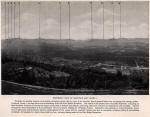 |
| 37 |
lots037 |
OVERLOOKING ASHEVILLE, NORTH CAROLINA, FROM SUNSET MOUNTAIN.
Names of
peaks and altitudes.
1. Richland Balsam.
............6540
2. Little
Bald.......................5330
3.
Bald...............................5400
4. Little
Pisgah....................5000
5.
Pisgah.............................5749
6. Cold
Mountain................6000
7. Double
Top....................4000
8. Smathers'
View...............4203
9-10. Newfound
Mountains...4000
11. Rocky
Face..................4504
12. Big
Butt........................4500
13. Crabtree
Bald...............5280
14. Sandy Mush
Bald..........5080
15. Max Patch
Mountain.....4560
16. Couch's
Peak................3100
17. Elk
Mountain.................3190
|
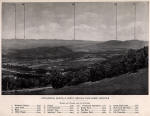 |
| 38 |
lots038 |
TWO
ASHEVILLE HOTELS, THE BATTERY PARK
AND THE
MANOR.
Good hotels are the rule at all mountain resorts of wealth and
refinement the world over. Those of the "Land of the Sky " are no
exception. The Battery Park is one of the best-known hotels in America;
one of the few to achieve distinction from the stay-at-home as well as
the traveling public from its prominence. Its situation is superb, high
upon a natural terrace on the outskirts of Asheville, fronting the
majestic display of the North Carolina mountains. Its sight was
fortified during the Revolutionary period and a camping-ground for
Confederate troops during the Civil War; hence the name, Battery Park.
The charming Manor House, of English quaintness, is a central figure of
Albemarle Park. The Manor is a unique compromise between a hotel and a
boarding-house; attractive, modest and refined.
|
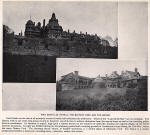 |
| 39 |
lots039 |
MOUNTAIN
PARK HOTEL, HOT SPRINGS—
ASHEVILLE
BY NIGHT.
About one mile beyond the gorge where the French Broad River breaks
through its mountain barriers is located the Mountain Park Hotel, at Hot
Springs, North Carolina, in the centre of a large and handsome private
park. The hotel stands close to the river upon whose banks are located
the modern bathing houses where the hot baths may be taken in handsome
marble tubs under the best medical advice. The waters of the hot springs
are especially efficacious in rheumatic and gouty ailments and have
wrought many wonderful cures. Many points of interest are in the
surrounding country. The remarkable Painted Rock which marks the
boundary between North Carolina and Tennessee is but six miles from this
hotel — Pack Square and Patton Avenue looking West. From the top of
Vance Monument, 105 feet high, streamers of electric lights extend to
adjacent buildings and down the intersecting streets. These form a roof
of dazzling brilliancy to this veritable "White Way," so familiar to
many thousands of visitors.
|
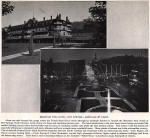 |
| 40 |
lots040 |
PACK SQUARE, ASHEVILLE, NORTH CAROLINA.
The business portion of this progressive city, situated at an
altitude of 2,250 feet, and having a population of 20,000 inhabitants,
centers about Pack Square. From here fifteen miles of electric car lines
radiate to all points, passing in close proximity to its many places of
interest. Abbeville is the county seat of historic Buncombe County, and
the geographical and social centre of the Western North Carolina
Plateau. A modern city of eleven million dollars assessed valuation,
with twenty-six churches, twenty elegantly equipped hotels, which
together with numerous finely appointed boarding houses is capable of
providing accommodation for twelve thousand guests. Climatically
Asheville's condition closely approaches perfection, occupying the
middle ground of latitude and altitude, enjoying a dry, genial,
healthful atmosphere, with an average of 280 days of sunshine during the
year. This picture shows Vance Monument with City Hall in background and
City Library at the right. Asheville with its Railroad Depot and Cotton
Mills extends westward to the bank of the French Broad River. It has an
excellent system of graded schools, a college for young women, normal
and collegiate institutes and the Bingham Military Institute for young
men. All in all the city is interesting as well as beautiful, where one
should feel at home and allow nature to work the healing powers of its
delightful atmosphere.
|
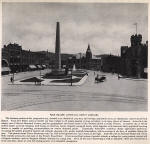 |
| 41 |
lots041 |
GROVE PARK, WEST ENTRANCE —THE MODEL VILLAGE OF
BILTMORE.
Grove Park, the latest acquisition to Asheville's park reservations.
One mile from Asheville's central Square, the entrance shown above opens
upon a magnificent expanse of natural scenery, comprising six hundred
acres. Within this area (which extends both sides of Charlotte Avenue)
on the east rises Sunset Mountain to an altitude of 3,250 feet, 1,000
feet above the city. An automobile road of easy grade is being
constructed to the summit, which with other winding roads, mountain
trails and an incline railroad, will render all parts of the mountain
easily accessible.
Biltmore is a station on the Southern Railway two miles east of
Asheville, just outside the entrance lodge to the Biltmore estate. Here
are the church and rectory, the post-office, the office of the estate,
the car-house in which is kept the private car of Mr. Vanderbilt, in
addition to the usual dependences, homes of the people of the estate.
The proprietor does not sell any of the handsome model houses, but rents
them. All are supplied with, modern conveniences of the most recent
improved sort. The church, entirely supported by Mr. Vanderbilt, is a
handsome stone edifice, and the surrounding cottages, all of one type,
with the well-paved streets give an effect quite foreign to this
country, especially to North Carolina.
|
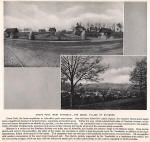 |
| 42 |
lots042 |
RIVERSIDE PARK AND LAKE
The popularity of this summer play ground is attested during each
warm season by daily throngs of recreators. Citizens and visitors alike
mingle in the participation of its varied pleasures. Here are music,
fireworks, moving pictures, swings, geological exhibits and baseball
grounds For those of quiet inclinations, shady walks for strolling and
nature study along the shores of a beautiful lake with rippled surface,
gay with happy boating parties Many thousands of visitors from the
torrid south, to avoid the summer's enervating heat, tarry at Asheville,
enjoying comfort, rest and recreation at this delightful resort with its
tranquil lake down by the swiftly flowing French Broad (Tahkeeostee)
River.
|
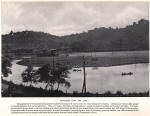 |
| 43 |
lots043 |
ASHEVILLE'S MOST POPULAR RECREATION
PARK.
Numerous charming natural parks, both within the city of Asheville
and its closely adjacent environments, evidence nature's bounteous
endowment to this favored city. Albemarle Park is one of the attractive
improvements about Asheville. The park embraces a tract thirty-four
acres in extent, including a charming combination of glen and mountain
side. Overlook Park, another popular resort, holding resistless
inducements for visitors and residents alike, is situated on Sunset
Mountain. A tower fifty feet in height enhances the magnificent mountain
view (described on preceding pages), while an excellent orchestra and
dancing pavilion in connection with a faultless cafe promotes the
pleasure of the numerous patrons. The Sunset Park Railway from the
terminus of Charlotte Street carline, affords a picturesque ride to the
summit of Sunset Mountain. Other Parks, including Grove and Kenilworth,
together with the cordial welcome extended by the Asheville Elks and
Tahkeeostee Clubs, to the modern social enjoyment of their splendidly
equipped homes and the freedom of the Country Club's 2,700 yard golf
links, situated on the picturesque slopes of Sunset Mountain, enable
Asheville to provide pleasant and healthful recreation for all classes.
|
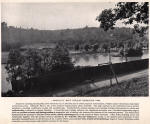 |
| 44 |
lots044 |
ASHEVILLE'S PUBLIC BUILDINGS.
1. City Hall.
2. Passenger Station,
Southern Railway.
3. Post Office.
4. Public Library.
5. Auditorium.
6. Buncombe County Court
House.
The above group comprises
Asheville's principal public buildings. The substantial growth and
progressive spirit of Asheville is well shown in her public buildings;
all of comparatively recent construction and together with her school
buildings, modern in every detail. In the Auditorium adequate provision
is made for conventions, placing at the disposal of all convention
bodies, without cost, this spacious building heated, lighted, admirable
in acoustics, having every modern requisite of committee rooms and
accommodations, with a seating capacity of 2500. Asheville's Public
Library occupies a commanding situation bordering on Pack Square. This
strikingly beautiful building, a gift to the Library Association in 1899
from G. W. Pack, in whose honor the square received its name, contains
11,000 volumes.
|
 |
| 45 |
lots045 |
CRYSTAL
FALLS —SOURCE OF ASHEVILLE'S
WATER
SUPPLY,
By a gravity system with intake below this beautiful fall, 520 feet
above and 20 miles distant, Asheville derives a water supply practically
limitless in quantity and of exceptionally rare purity. Scattered
throughout 10,000 acres of virgin forests, recently purchased by the
city, are hundreds of perennial springs, whose crystal waters mingling
in their precipitous descent down the mountain's bouldered slopes into
one beautiful mountain stream, carry five million gallons of North Fork
water daily to supply the houses and industries of Asheville. The
boundaries of this vast forest-covered watershed are substantially
fenced and the entire tract daily patrolled by a sufficient number of
wardens to prevent the ingress of anything possible to pollute the
waters.
|
 |
| 46 |
lots046 |
KALMIA, OR MOUNTAIN LAUREL.
Local names generally apply to plants or shrubs that form a feature
of any landscape rather than their true botanical title; thus the
Kalmia, named in honor of the Swedish botanist, Peter Kalm, a genus of
handsome, flowering North American shrubs, is popularly known as laurel.
The best known and most conspicuous species is certainly the mountain
laurel which grows in great profusion amid the hills and mountain
ravines of "The Land of the Sky." Here, also, it is often miscalled
mountain ivy, while the rhododendron, shown on the opposite page, is
called laurel, which it is not. The leaves of the Kalmia are scattered,
or in whorls or tufts of a bright green color and a leathery texture.
The flowers, which vary in color from pure white to deep rose color, are
borne in large terminal heads, clusters of shallow, bell-shaped
blossoms, small in their individuality, but conspicuous en masse. It is
commonly supposed to be impossible to transplant the mountain laurel;
but if the head of the tree be severely cut back so that nothing but
naked branches are left, and the plant removed to good garden soil in
early spring, it will soon throw out new shoots and by autumn be well
clothed with foliage.
|
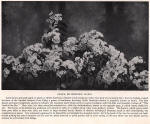 |
| 47 |
lots047 |
THE GREAT
RHODODENDRON FROM
"THE LAND
OF THE SKY"
The rhododendron is the king of shrubs; for beauty of form and
foliage, profusion and variety of flowers, none other can equal them. It
seems to particularly seek Alpine heights and mountain glens, being very
common in the mountains of the Middle States and along their
watercourses as far south as Georgia. Rhododendrons are found not only
among the Alleghenies, but in the Rocky and Cascade Mountains, in the
mountains of Europe and Asia, whilst a most magnificent species belongs
to the Himalaya. In the deep, dark woods of the Southern States the
Rhododendron flourishes best, and in the cedar swamps it often forms the
principal undergrowth. Hereof grows from six to twenty feet high, with
the habit of a shrub rather than a tree. The flowers appear on the
Asheville plateau in June and July. They grow in large clusters of
blossoms, each an inch broad, white of pale rose colored greenish at the
throat and spotted with yellow or reddish dots. A variety is sometimes
met having pure white with purplish blossoms. This species, the Great
Rhododendron is not common in cultivation.
|
 |
| 48 |
lots048 |
A
PICTURESQUE BIT AT WAYNESVILLE, NORTH CAROLINA — GOOD-BYE THE OLD NORTH
STATE.
If, in our preface, the entire space was devoted to the Asheville
plateau, then our finis will be given to North Carolina, the State, and
its place amid the "Empire of the South." When, on July 4th, 1584, Sir
Walter Raleigh's expedition first landed on the soil of America and
touched the shores of North Carolina, there began the first English
occupation of the continent. New England makes no authentic claim of
French or English settlement until early in the i6oos, while it was not
until 1620 that the Pilgrim Fathers first saw Massachusetts Bay. From
its birth as a colony North Carolina has always stood for freedom and
the rights of the (governing) people. The "Old North State" was the
first to send to Philadelphia representatives of the people, and they
were instructed to propose or concur in the movement for independence.
She, too, was the first of the colonies to establish entire religious
freedom, and the last to pass the ordinance of secession from the Union.
Once in she did her part grandly, many of the bloody conflicts of the
Rebellion being fought out upon her soil, and at the end came out
completely bankrupt. Since that time no Southern State has made greater
progress in development. North Carolina has wonderful resources; with a
greater diversity of climate than any State except California, it could
better maintain its inhabitants independent of outside markets than any
territory of equal size in the world.
|
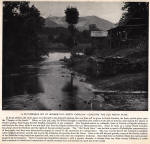 |


